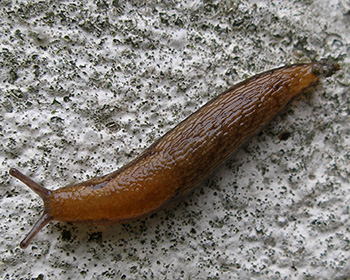Been Slimed Lately? Well. They Do it All the Time
Been Slimed Lately? Well. They Do it All the Time
By the Site Ecology Team (SET) and Wildlife and Industry Together (WAIT)
March 29, 2016

Photo courtesy of Guttorm Flatabo
Some guys just live to be slimed and without it they would soon wither away and die. Absurd you say, then, you must be thinking about a television show where the green slim rains down on participants. We’ll be going down a slippery path with this one. What I write might not be to your tastes but there are plenty of people who would beg to differ with you. We’ll escargot anyway. The choice to be made is shelled or unshelled and is there really any difference. So what is the difference between Slug and Snail? Those of you who said the spelling, there’s no need to read further for you’ve got the topic covered.
Mollusks of the Land, as they are called, are gastropod relatives of the oysters, octopus, squid and clams. Collectively they number more than six thousand species worldwide with most being aquatic. The land snails and slugs interest us today. They are known for their mucus trails and appetite for tender vegetables and flowers.

Photo courtesy of Macrophile
What makes the two different? The obvious thing is the shell of the snail that protects it and grows with it. The shell joins to the body and holds the organs. When disturbed or in an in-hospitable place, the snail can withdraw and plug the opening. The slug is exposed and must rely on its secretions and staying in a damp location. Both prefer nocturnal activities when there is less stress of drying out. Both propel themselves forward by sending waves of small contractions from the back of its base toward the front. The mucus serves as a barrier against the surface being traversed and protects their body from abrasion. The mucus comes from a gland in the very large muscular flat foot (gastropod). The common garden snail is the slowest moving land bound animal traveling a whopping 0.03 mph (0.05 kph) at full throttle. Some slugs grow to be 15” long while snails only 10” long.
Slugs can live up to 6 years if they go easy on the salt intake. Snails usually live only 3 years. Maneuvering a travel home all day takes a lot of energy.
Caution: The following paragraph may not be suitable for wee-ones:
Most land snails and slugs possess both male and female parts. In some species, an individual may behave as male for a while, then as a female. When snails or slugs mate, two individuals pull up next to one another, arrange themselves so that the male part of one is opposite the female part of the other, and then each ejects sperm into the female opening of the other. In a few snail and slug species, self-fertilization occurs -- an hermaphroditic individual mates with itself and produces offspring. Land gastropods lay eggs.
From a landscaping or gardening standpoint, why be concerned?
Your choice of plant can greatly affect how difficult your battle with snails and slugs will be. Some plants that are seriously damaged include basil, beans, cabbage, dahlia, delphinium, hosta, lettuce, marigolds, strawberries, and many vegetable plants. On the other hand, there are many plants that resist damage from snails and slugs including begonias, California Golden Poppy, fuchsias, geraniums, impatiens, lantana, nasturtiums, and purple robe cup flower. Plants with stiff leaves and highly scented foliage like lavender, rosemary, and most ornamental woody plants and ornamental grasses are also not seriously affected. If you design your landscape using plants like these, you are likely to have very limited damage from snails and slugs.
For control, there are commercial products that are ingested by the slugs and snails and are non-toxic to pets and small children. A well-known solution is to have a “Slug Fest” and invite yard slugs and snails to a beer bash. They are notorious for getting stone drunk and perishing in their own brew. Those who don’t go off the deep end can usually be enticed to sleep it off under a board or half a cantaloupe, which can easily be removed to put them out of your misery, humanely.
Some species are known to be intermediary host for parasites, so make sure that any beer-battered slugs are thoroughly cooked before downing them.
References



